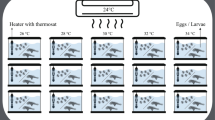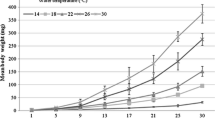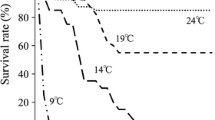Abstract
In laboratory conditions, effects of rearing temperature and stocking density were examined on hatching of fertilized egg and growth of auricularia larvae of Apostichopus japonicus respectively. Data series like larval length and density, metamorphic time, and survival rate of the larvae were recorded. Statistics showed that for A. japonicus, survival rate (from fertilized egg to late auricularia) decreased significantly with the increasing rearing temperature (P<0.05). At different temperatures SGR was statistically significant as well (P<0.05) from day 1, and maximal SGR was found on day 9 at 24°C (159.26±3.28). This study clearly indicated that at low temperature (<24°C), metamorphic rate was remarkably higher than at higher temperature (>26°C). Hatching rate was significantly different between 0.2–5 ind./ml groups and 20–50 ind./ml groups. Rearing larvae at the higher density had the smaller maximal-length, whereas needed longer time to complete metamorphosis. This study suggested that 21°C and 0.4 ind./ml can be used as the most suitable rearing temperature and stocking density for large -scale artificial breeding of A. japonicus’s larvae.
Similar content being viewed by others
References
Asha P S, Muthiah P. 2005. Effects of temperature, salinity and pH on larval growth, survival and development of the sea cucumber Holothuria spinifera Theel. Aquaculture, 250: 823–829.
Avila C, Grenier S, Tamse C T, Kuzirian A M. 1997. Biological factors affecting larval growth in the nudibranch mollusc Hermissenda crassicornis (Eschscholtz, 1831). J. Exp. Mar. Biol. Ecol., 218: 243–262.
Barnett C W, Pankhurst N W. 1998. The effects of common laboratory and husbandry practices on the stress response of greenback flounder Rhombosolea tapirina (Gunther, 1862). Aquaculture, 162: 313–329.
Battaglene S C. 1999. Culture of tropical sea cucumbers for stock restoration and enhancement. Naga, ICLARM Q 22: 4–10.
Chen C P, Chian C S. 1990. Short note on the larval development of the sea cucumber Actinopyga echinites (Echinodermata:Holothuroidea). Bull. Inst. Zool. Acad. Sin., 29: 127–133. (in Chinese with English abstract)
Chen J X. 2003. Overview of sea cucumber farming and sea ranching practices in China. SPC Beche-de-mer Information Bulletin, 5: 18–23.
Claudia A B, Mauricio F L, Enrique B S, Rodrigo L, Ximena M. 2007. Effects of temperature and lipid droplet adherence on mortality of hatchery-reared southern hake Merluccius australis larvae. Aquaculture., 270: 535–540.
Cragg S M. 1980. Swimming behavior of the larvae of Pecten maximus (L.) (Bivalvia). J. Mar. Biol. Assoc. U. K., 60: 551–564.
Crisp D J. 1974. Factors Influencing the Settlement of Marine Invertebrate Larvae. In: P T Grant and A M Mackie, Editors. Chemoreception in Marine Organisms, Academic Press, New York. p. 177–263.
Deeming D C. 1991. Reasons for the dichotomy in the need for egg turning during incubation in birds and retiles. In: Egg Incubation: Its Effect on Embryonic Development in Birds and Reptiles. Deeming D C, Ferguson M W J eds. Cambridge University Press, Cambridge, p. 307–323.
Dong Y W, Dong S L, Ji T T. 2008. Effect of different thermal regimes on growth and physiological performance of the sea cucumber Apostichopus japonicus Selenka. Aquaculture, 275: 329–334.
Du W G., Ji X. 2001. Influence of incubation temperature on embryonic use of material and energy in the Chinese soft-shelled turtle (Pelodiscus sinensis). Acta Zoologica Sinica, 47(5): 512–517. (in Chinese with English abstract)
Ito S, Kitamura H. 1997. Induction of larval metamorphosis in the sea cucumber Stichopus japonicus by periphitic diatoms. Hydrobiologia, 358: 281–284.
Ito S, Kitamura H. 1998. Technical development in seed production of the Japanese sea cucumber, Stichopus japonicus. SPC Beche-de-mer Inf. Bull., 10: 24–28.
Jean-Francois H, Annie M. 1996. Early development, settlement, growth, and spatial distribution of the sea cucumber Cucumaria frondosa (Echinodermata: Holothuroidea). Can. J. Fish. Aquat. Sci., 53(2): 253–271.
Liao C Y. 1987. Metamorphosis and living habit of the larvae of the sea cucumber Stichopus japonicus Selenka. J. Shandong College of Oceanology, 17(1): 85–94.
Liu B Z, Dong B, Tang B J, Zhang T, Xiang J H. 2006. Effect of stocking density on growth,settlement and survival of clam larvae, Meretrix meretrix. Aquaculture, 258: 344–349.
Liu L M. 1996. Growth and development of Paralichthys olivaceus in metamorphosis period at different temperatures. Marine Sciences, 4: 58–63. (in Chinese with English abstract))
Loosanoff V L, Davis H C. 1963. Rearing of bivalve molluscs. In: Russell F S ed. Advances in Marine Biology, Vol. 1, Academic Press, London. p. 1–36.
MacDonald B A. 1988. Physiological energetics of Japanese scallop Patinopecten yessoensis larvae. J. Exp. Mar. Biol. Ecol., 120: 155–170.
McGurk M. 1984. Effects of delayed feeding and temperature on the age of irreversible starvation and on the rates of growth and mortality of Pacific herring larvae. Marine Biology, 84(1): 13–26.
Montero D, Izqueerdo M S, Tort L. 1999. High stocking density produces crowding stress altering some physiological and biochemical parameters in gilthead seabream, Sparus aurata, juveniles. Fish Physiol. Biochem., 20(1): 53–60.
Orensanz J M, Parma A M, Iribarne O O. 1991. Population Dynamics and Management of Natural Stocks. In: Shumway S E ed. Scallops: Biology, Ecology and Aquaculture, Elsevier, New York. p. 625–713.
Pan L Q, Ma S, Wang K X. 1997. Effects of temperature on growth development and digestive enzyme activities of the larvae of Penaeus chinensis. Journal of Fishery Sciences of China, 4: 17–22. (in Chinese with English abstract)
Ramofafia C, Gervis M, Bell J. 1995. Spawning and early larval rearing of Holothuria atra. SPC Beche-de-mer Inf. Bull., 7: 2–7.
Sergio B, Masatomo T, Yoh Y, Masaru T. 2006. Effect of stocking density on growth, digestive enzyme activity and cortisol level in larvae and juveniles of Japanese flounder Paralichthys olivaceus. Aquaculture, 259: 432–443.
Stephen C B, J Evizel S, Christian R, Idris L. 2002. Spawning induction of three tropical sea cucumbers, Holothuria scabra, H.fuscogilva and Actinopyga mauritiana. Aquaculture, 207: 29–47.
Sui X L, 1987. The main factors influencing the larval development and survival rate of the sea cucumber. Oceanologia et Sinica, 20(4): 314–321.
Sui X L, 1990. Aquaculture of Sea Cucumber, Apostichopus japonicus, Agriculture Press, Beijing, China. (in Chinese)
Sui X L. 2004. The advancement and outlook of cultural breeding and aquatics technique of Apostichopus japonicus. Fisheries Science, 9: 32–34
Vijayan M M, Ballantyne J S, Leatherland J F, 1990. High stocking density alters the energy metabolism of brook charr, Salvelinus fontinalis. Aquaculture, 88: 371–381.
Villarreal H, Ocampo L. 1993. Effect of size and temperature on the oxygen consumption of the brown shrimp Peaneus californiensis (Holmes, 1900). Comp. Biochem. Physiol., 106 A(1): 97–101.
Wendelaar B, 1997. The stress response in fish, Physiological Reviews, 77: 591–625.
Yang H S, Zhou Y, Zhang T, Yuan X T, Li X X, Liu Y, Zhang F S. 2006. Metabolic characteristics of sea cucumber Apostichopus japonicus (Selenka) during aestivation. J. Experimental Marine Biology and Ecology, 330(2): 505–510.
Yu M Z, Chang Y Q. 2008. The effects of low temperature on some physiological phenomena in different populations of sea cucumber Apostichopus japonicus juveniles. J. Dalian Fisheries University, 23(1): 31–36. (in Chinese with English abstract)
Zhang H F, Liu X C, Wang Y X, Huang G G, Luo G W. 2006. Effects of temperature, salinity and pH on hatch and larval activity of Epinephelus coioides. Journal of Tropical Oceanography, 25(2): 31–36. (in Chinese with English abstract)
Author information
Authors and Affiliations
Corresponding author
Additional information
Supported by the National High Technology Research and Development Program of China (863 Program) (No. 2006AA10A411), and Shandong Agriculture Seed Stock Projects
Rights and permissions
About this article
Cite this article
Liu, G., Yang, H. & Liu, S. Effects of rearing temperature and density on growth, survival and development of sea cucumber larvae, Apostichopus japonicus (Selenka). Chin. J. Ocean. Limnol. 28, 842–848 (2010). https://doi.org/10.1007/s00343-010-9092-4
Received:
Accepted:
Published:
Issue Date:
DOI: https://doi.org/10.1007/s00343-010-9092-4




